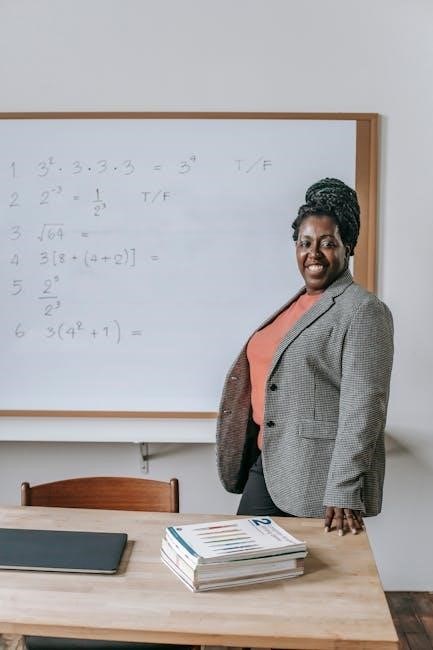Saxon Math Course 2 is a comprehensive curriculum designed for middle school students, focusing on foundational math skills, problem-solving, and algebraic thinking.
It emphasizes incremental learning, distributed practice, and real-world applications, preparing students for higher-level mathematics and alignment with Common Core State Standards.
The course includes workbooks, tests, and teacher resources, providing a structured approach to math education and fostering long-term understanding and confidence in students.

Overview of Saxon Math Curriculum

The Saxon Math curriculum is a well-structured, incremental approach to math education, designed to build foundational skills and conceptual understanding gradually.
It integrates traditional units with distributed practice, allowing students to revisit and master concepts throughout the year, ensuring long-term retention and algebraic thinking.
The curriculum aligns with Common Core State Standards, making it a popular choice for classrooms and homeschooling, with resources like workbooks, teacher manuals, and answer keys to support learning.
Its emphasis on problem-solving, real-world applications, and cumulative assessments prepares students for higher-level math, fostering confidence and a deep understanding of mathematical principles.
Importance of Saxon Math Course 2 in Middle School Education
Saxon Math Course 2 plays a pivotal role in middle school education by providing a robust foundation in mathematics, essential for future academic success.
It emphasizes problem-solving, critical thinking, and algebraic reasoning, preparing students for advanced math courses and real-world applications.
The curriculum’s incremental approach ensures mastery of skills through distributed practice and cumulative reviews, fostering confidence and a deep understanding of mathematical concepts.
By aligning with Common Core State Standards, Saxon Math Course 2 equips students with the skills needed to excel in high school and beyond, making it a cornerstone of middle school math education.
Structure of Saxon Math Course 2
Saxon Math Course 2 is structured to provide a systematic and comprehensive learning experience, with lessons divided into clear, manageable segments.
Each lesson follows a 4-step problem-solving process: understand the problem, devise a plan, carry out the plan, and review the solution.
The course includes a student textbook, workbook, and tests, with an answer key for self-assessment and monitoring progress.
Cumulative tests every 10 lessons ensure mastery of skills, while distributed practice reinforces previously learned concepts throughout the year.
This structured approach ensures a balanced and progressive development of mathematical skills, aligning with educational standards and fostering long-term understanding.

Key Features of Saxon Math Course 2
Saxon Math Course 2 emphasizes incremental learning, promoting steady skill development and understanding through structured lessons and regular practice exercises.
It incorporates distributed practice, reinforcing previously learned concepts and ensuring long-term retention of mathematical knowledge and problem-solving abilities.
Incremental Approach to Learning Mathematics
The Saxon Math Course 2 employs an incremental approach, breaking down mathematical concepts into manageable, logically sequenced lessons.
Each lesson introduces a new skill or concept, building on previously learned material to ensure a solid foundation for future learning.
This method fosters deep understanding and long-term retention, allowing students to master skills at their own pace and connect concepts seamlessly.
Distributed Practice and Cumulative Review
Saxon Math Course 2 incorporates distributed practice and cumulative review to reinforce learning and ensure long-term retention of mathematical concepts.
Lessons are structured to reintroduce previously taught skills alongside new material, preventing the “forgetting curve” and fostering a deep understanding of math.
Cumulative tests are regularly administered to assess mastery of all concepts covered, while practice exercises are designed to strengthen problem-solving abilities and algebraic thinking.
This approach ensures students build a robust foundation, making it easier to tackle increasingly complex math problems as they progress through the course.
Integration of Algebraic Thinking
Saxon Math Course 2 places a strong emphasis on the integration of algebraic thinking, preparing students for advanced math by introducing foundational algebraic concepts early on.
Students are introduced to variables, simple equations, and basic algebraic expressions, fostering problem-solving skills and logical reasoning.
The curriculum incorporates a 4-step problem-solving process: understand, plan, solve, and verify, helping students develop a systematic approach to math challenges.
This focus on algebraic thinking aligns with Common Core State Standards, ensuring students are well-prepared for higher-level mathematics in subsequent years.
By integrating algebraic concepts throughout the course, Saxon Math Course 2 builds a strong mathematical foundation and nurtures critical thinking abilities in students.
Alignment with Common Core State Standards
Saxon Math Course 2 is designed to align with Common Core State Standards, ensuring students meet rigorous mathematical expectations and develop a deep understanding of key concepts.
The curriculum focuses on critical areas such as problem-solving, algebraic thinking, and the mastery of fractions, ratios, and geometry, all of which are central to the Common Core framework.
By incorporating distributed practice and cumulative review, Saxon Math Course 2 helps students build a strong foundation in mathematics, consistent with the standards’ emphasis on long-term understanding and real-world application.
This alignment ensures that students are well-prepared for higher-level mathematics and can confidently tackle challenges aligned with Common Core requirements.
The structured approach of Saxon Math Course 2 supports the Common Core’s goal of developing mathematically proficient students capable of critical thinking and problem-solving.

Understanding the Saxon Math Course 2 Answer Key
The Saxon Math Course 2 Answer Key provides detailed solutions and explanations for student exercises, fostering self-assessment and deeper understanding of mathematical concepts and problem-solving strategies.
It serves as an essential resource for both students and educators, promoting accuracy and confidence in mastering the curriculum’s rigorous math content and skills.
By aligning with the course structure, the answer key supports effective learning and teaching, ensuring students grasp key ideas and apply them successfully in various mathematical scenarios.
Purpose of the Answer Key
The Saxon Math Course 2 Answer Key is designed to provide students and educators with accurate solutions to textbook problems, ensuring clarity and understanding of mathematical concepts.
It serves as a valuable tool for self-assessment, allowing students to verify their work and identify areas needing improvement.
The answer key aligns with the curriculum’s emphasis on incremental learning and distributed practice, reinforcing problem-solving skills and algebraic thinking.
By offering detailed explanations, it supports both independent study and classroom instruction, helping students build confidence and mastery of math principles.
This resource is essential for aligning teaching strategies with learning outcomes, ensuring students meet educational standards effectively.
How to Use the Answer Key Effectively
To use the Saxon Math Course 2 Answer Key effectively, students should complete assignments independently before referencing the key to identify errors and understand concepts deeply.
Teachers can utilize the key for consistent grading and creating accurate answer sheets, while also designing additional practice exercises based on common student challenges.
The key aligns with Saxon’s incremental learning approach, reinforcing previously learned skills and ensuring a strong foundation for advanced mathematics.
By integrating the Answer Key with workbooks and online resources, students can enhance their learning experience and build problem-solving confidence.
Regular review and focused practice using the Answer Key help students master math principles and achieve long-term success in their studies.
Common Mistakes to Avoid When Using the Answer Key
- Over-reliance on the answer key can hinder independent problem-solving skills and deep conceptual understanding.
- Students should avoid rushing through problems without attempting them first, as this limits the learning process.
- Copying answers without reviewing and understanding the steps can lead to gaps in mathematical reasoning.
- Teachers should ensure students don’t use the answer key as a shortcut but rather as a tool for verification and correction.
Encourage students to complete assignments independently before referencing the key and emphasize the importance of understanding mistakes to improve problem-solving abilities.

Key Concepts and Skills Covered in Saxon Math Course 2
Saxon Math Course 2 focuses on building foundational math skills, including fractions, ratios, probability, geometry, and pre-algebra concepts, while fostering problem-solving and algebraic thinking.
Students develop understanding of real-world applications and mathematical reasoning through structured lessons and cumulative practice.
Fractions and Ratios
Fractions and ratios are fundamental concepts in Saxon Math Course 2, providing students with essential skills in handling numerical relationships. The curriculum introduces fraction operations—addition, subtraction, multiplication, and division—through incremental lessons and practice exercises. Ratios are explored in depth, enabling students to understand proportionality and equivalent relationships. Real-world applications, such as dividing resources or comparing quantities, help students grasp practical uses of these concepts. The answer key serves as a valuable resource, offering step-by-step solutions and explanations to reinforce understanding and improve problem-solving abilities.
Probability and Statistics
Probability and statistics are introduced in Saxon Math Course 2 to help students understand data analysis and chance events. Lessons cover basic probability concepts, such as predicting outcomes and calculating likelihoods, while statistics involves interpreting data sets and creating visual representations like bar graphs and histograms. Real-world applications, such as analyzing game outcomes or survey results, make these concepts relatable. The answer key provides detailed solutions to exercises, ensuring students can verify their work and grasp underlying principles. This section builds foundational skills for more advanced statistical reasoning in higher grades.
Geometry and Measurement
Saxon Math Course 2 introduces essential geometry and measurement skills, focusing on understanding shapes, their properties, and practical applications. Students learn to calculate perimeter, area, and volume of various figures, including triangles, rectangles, and cylinders. The curriculum emphasizes converting units of measurement and solving word problems involving time, distance, and capacity. Visual aids and real-world scenarios help students connect abstract concepts to tangible situations. The answer key provides step-by-step solutions for complex geometry problems, ensuring accuracy and reinforcing problem-solving strategies. This section equips students with the foundational knowledge needed for advanced geometry and applied mathematics in later grades.
Pre-Algebra Concepts
Saxon Math Course 2 lays a strong foundation in pre-algebra, introducing students to variables, equations, and functions. Lessons focus on solving linear equations, graphing simple functions, and understanding inequalities. The curriculum also covers properties of operations, such as commutative and associative properties, essential for algebraic manipulation. Students learn to simplify expressions and solve multi-step problems, building logical reasoning and problem-solving skills. The answer key provides detailed solutions for pre-algebra exercises, helping students verify their work and understand complex concepts. This section bridges arithmetic and higher-level algebra, ensuring students are well-prepared for advanced math studies in subsequent grades.
Real-World Problem-Solving Activities
Saxon Math Course 2 integrates real-world problem-solving activities to help students connect mathematical concepts to practical scenarios. These activities include applications in finance, geometry, and data analysis, fostering critical thinking and practical application skills. The curriculum encourages students to use math to solve everyday problems, such as calculating costs, measuring distances, and interpreting statistics. The answer key provides solutions to these real-world problems, enabling students to verify their approaches and gain confidence in their abilities. By emphasizing real-world relevance, Saxon Math Course 2 prepares students to apply mathematical knowledge effectively in various contexts, making learning engaging and meaningful.

Resources and Supplements for Saxon Math Course 2
Saxon Math Course 2 offers a workbook, teacher’s manual, online resources, and manipulatives. The answer key provides solutions, ensuring comprehensive support for students and teachers alike.
Workbook and Student Textbook
The Saxon Math Course 2 Workbook and Student Textbook are essential resources for structured learning. The workbook provides daily practice problems, ensuring consistent skill reinforcement and mastery of concepts like fractions, ratios, and geometry. Each lesson builds incrementally, with clear instructions and examples. The student textbook complements the workbook with detailed explanations, real-world applications, and step-by-step solutions to promote deep understanding. Together, these materials create a comprehensive learning experience, fostering problem-solving skills and algebraic thinking. The textbooks are designed to align with the Common Core State Standards, preparing students for advanced mathematics. Regular use of these resources helps students develop confidence and proficiency in math.
The workbook and textbook are supported by the Saxon Math Course 2 Answer Key, which offers solutions to exercises, aiding in self-assessment and understanding. This integrated approach ensures students can track their progress and identify areas for additional practice, reinforcing their mathematical foundation.
Teacher’s Manual and Instructional Guides
The Teacher’s Manual for Saxon Math Course 2 is a vital resource for educators, offering detailed lesson plans, teaching strategies, and tools to support effective instruction. It includes reteaching masters, standards of success, and adaptations to meet diverse learning needs. The manual aligns with the course’s incremental approach, providing step-by-step guidance for introducing concepts like fractions, probability, and geometry. Additionally, the instructional guides offer suggestions for real-world applications and problem-solving activities, fostering engagement and deeper understanding. The manual also includes the answer key on a CD-ROM, allowing teachers to efficiently assess student progress and provide targeted feedback, ensuring a comprehensive and structured teaching experience.
Online Resources and Educational Games
Online resources and educational games complement Saxon Math Course 2, offering interactive learning experiences that enhance understanding and engagement. Websites like MathHelp.com provide over 1,000 online math lessons aligned with Saxon textbooks, featuring a personal math teacher inside every lesson. Brainly serves as an AI learning companion, creating a responsive environment for students to explore questions, test prep, and instant support. Additionally, platforms like Teachers Pay Teachers offer original educational resources, including study guides and activities tailored to Saxon Math Course 2. These tools, combined with downloadable answer keys, allow students to practice problems, review concepts, and assess their progress independently, fostering a dynamic and self-directed learning experience.
Manipulatives for Hands-On Learning
Manipulatives play a crucial role in Saxon Math Course 2, providing hands-on experiences that enhance understanding of mathematical concepts. Tools like base-ten blocks, fraction strips, and geometry shapes allow students to visualize and interact with problems, making abstract ideas more concrete; These resources are particularly effective for topics such as fractions, ratios, and geometry, helping students develop a deeper grasp of relationships between numbers and shapes. Manipulatives also encourage critical thinking and problem-solving skills, aligning with the course’s emphasis on real-world applications and algebraic reasoning. They complement the structured curriculum, offering a tactile approach to learning that fosters engagement and long-term retention of mathematical principles.

Challenges and Solutions for Students
Students often face challenges with Saxon Math Course 2’s unique approach and fast-paced lessons. Utilizing manipulatives, online resources, and forums can provide effective solutions and support.
Common Difficulties Faced by Students
Students often struggle with the unique, incremental approach of Saxon Math Course 2, finding it challenging to keep pace with the continuous introduction of new concepts.
The dense structure and lack of immediate answers in the workbook can frustrate learners, while the emphasis on long-term retention requires consistent effort and practice.
Additionally, the integration of algebraic thinking and real-world problem-solving can overwhelm some students, making the answer key an essential tool for clarification and self-assessment.
Strategies to Improve Conceptual Understanding
To enhance understanding, students should use manipulatives and real-world applications to visualize math concepts, making them more tangible and relatable.
Incorporating educational games and digital tools can engage learners and provide interactive practice, reinforcing skills and fostering a deeper grasp of the material.
Encouraging regular use of the answer key for self-assessment helps identify and correct mistakes early, while breaking problems into smaller steps promotes clarity and reduces overwhelm.
Fostering a growth mindset and consistent practice are key to building confidence and mastery in Saxon Math Course 2.
Role of Technology in Enhancing Learning
Technology enhances learning by providing interactive resources like educational games and online platforms such as MathHelp.com, which offer step-by-step solutions and personalized math lessons aligned with Saxon Math textbooks.
Tools like Brainly and digital manipulatives engage students, while online communities and forums provide support for both students and educators, fostering a collaborative learning environment and improving overall math proficiency.

Assessment and Evaluation in Saxon Math Course 2
Saxon Math Course 2 uses cumulative tests and regular assessments to evaluate student progress, with answer keys providing accurate feedback and guiding self-assessment for improved understanding.
Types of Assessments
Saxon Math Course 2 incorporates a variety of assessments to monitor student progress, including regular quizzes, cumulative tests, and a baseline test at the beginning of the year. These evaluations are designed to measure mastery of skills and identify areas needing additional practice. Quizzes are administered at regular intervals to reinforce learning, while cumulative tests assess retention of concepts taught throughout the year. The answer key provided ensures accurate grading and immediate feedback. This structured approach helps students build confidence and prepares them for higher-level mathematics, aligning with the curriculum’s focus on incremental learning and long-term understanding.
Importance of Cumulative Tests
Cumulative tests in Saxon Math Course 2 are crucial for assessing long-term retention and understanding of mathematical concepts. They cover a wide range of topics taught throughout the year, ensuring students retain and apply previously learned skills. These tests help identify knowledge gaps and reinforce the curriculum’s incremental learning approach. By using the answer key, teachers can provide accurate grading and constructive feedback, guiding students toward improvement. Cumulative tests also prepare students for high-stakes exams and foster a deep understanding of mathematics, essential for future academic success. Regular cumulative assessments ensure students are well-prepared and confident in their mathematical abilities.
Using the Answer Key for Self-Assessment
The Saxon Math Course 2 answer key is an invaluable tool for self-assessment, enabling students to evaluate their understanding and accuracy. By comparing their work to the provided answers, students can identify errors, correct mistakes, and reinforce their learning. Regular self-assessment fosters independence, enhances problem-solving skills, and builds confidence. The answer key’s structured format allows students to track progress and understand concepts deeply. This practice also promotes accountability and ensures students are well-prepared for cumulative tests and future math challenges. Utilizing the answer key consistently supports Saxon’s incremental approach, helping students master skills and achieve long-term success in mathematics.

Teacher Support and Professional Development
Saxon Math Course 2 provides teacher manuals, training programs, and online forums to support educators in delivering effective instruction and professional growth.
Available Resources for Teachers
Teachers using Saxon Math Course 2 have access to comprehensive resources, including detailed teacher manuals, instructional guides, and answer keys.
- Teacher manuals provide lesson plans, teaching strategies, and examples to support effective instruction.
- Instructional guides offer tips for differentiating instruction and addressing diverse learner needs.
- Online communities and forums allow educators to share ideas, ask questions, and collaborate with peers.
- Professional development opportunities, such as workshops and training programs, enhance teaching skills.
These resources empower teachers to deliver high-quality math education and support student success in Saxon Math Course 2.
Workshops and Training Programs
Workshops and training programs for Saxon Math Course 2 are designed to equip teachers with effective instructional strategies and a deep understanding of the curriculum.
- These programs cover lesson planning, differentiated instruction, and integrating real-world problem-solving activities.
- Teachers learn how to use manipulatives, online resources, and the answer key to enhance student learning.
- Hands-on activities and collaborative sessions help educators master the incremental approach and cumulative review methods.
- Professional development opportunities ensure teachers are well-prepared to support students in achieving math proficiency.
These workshops are essential for maximizing the effectiveness of Saxon Math Course 2 in the classroom.
Online Communities and Forums for Educators
Online communities and forums dedicated to Saxon Math Course 2 provide educators with a platform to share resources, discuss challenges, and collaborate on best practices.
- These forums offer access to lesson plans, answer keys, and innovative teaching strategies.
- Teachers can engage with peers, ask questions, and gain insights into effectively implementing the curriculum.
- Many communities feature expert advice, video tutorials, and tips for integrating manipulatives and technology.
- They also serve as a hub for exchanging ideas on addressing common student difficulties and enhancing conceptual understanding.
- Participating in these forums fosters professional growth and helps educators optimize their teaching methods for Saxon Math Course 2.
These online spaces are invaluable for educators seeking support and collaboration in delivering high-quality math instruction.
Saxon Math Course 2 provides a structured, incremental approach to learning, supported by comprehensive resources like the answer key, ensuring long-term math understanding and student confidence.
Final Thoughts on Saxon Math Course 2
Saxon Math Course 2 is a well-structured curriculum that effectively builds foundational math skills and algebraic thinking in middle school students. The answer key is an invaluable resource for both students and educators, providing clear solutions and aiding in self-assessment. Its incremental approach ensures that concepts are introduced and reinforced gradually, aligning with Common Core State Standards. The availability of workbooks, tests, and online resources makes it a comprehensive tool for learning. By fostering continuous practice and understanding, Saxon Math Course 2 equips students with the confidence and skills needed for future academic success in mathematics.
Encouraging Student Success
Saxon Math Course 2 empowers students to achieve success through its structured approach and supportive resources. The answer key provides clear solutions, helping students identify errors and understand concepts deeply. Regular practice, cumulative reviews, and real-world applications foster confidence and mastery. Teachers can use the answer key to track progress and offer targeted support. Additionally, manipulatives and online tools enhance engagement. Encouraging students to use the answer key for self-assessment promotes independence and accountability. By addressing challenges early and celebrating progress, students develop a positive mindset toward math. This comprehensive support system ensures students are well-prepared for future academic challenges.
Importance of Continuous Practice
Continuous practice is vital in Saxon Math Course 2, as it reinforces skills and builds a strong mathematical foundation. Regular practice helps students retain concepts, apply them to new problems, and develop problem-solving fluency. The curriculum’s incremental approach ensures that skills are revisited and expanded upon, preventing knowledge gaps. By consistently working through lessons and reviews, students gain confidence and mastery. The answer key serves as a valuable tool for self-assessment, allowing students to identify and correct mistakes. Over time, persistent practice fosters deep understanding and prepares students for more complex math in the future. Consistency is key to achieving long-term success in mathematics.